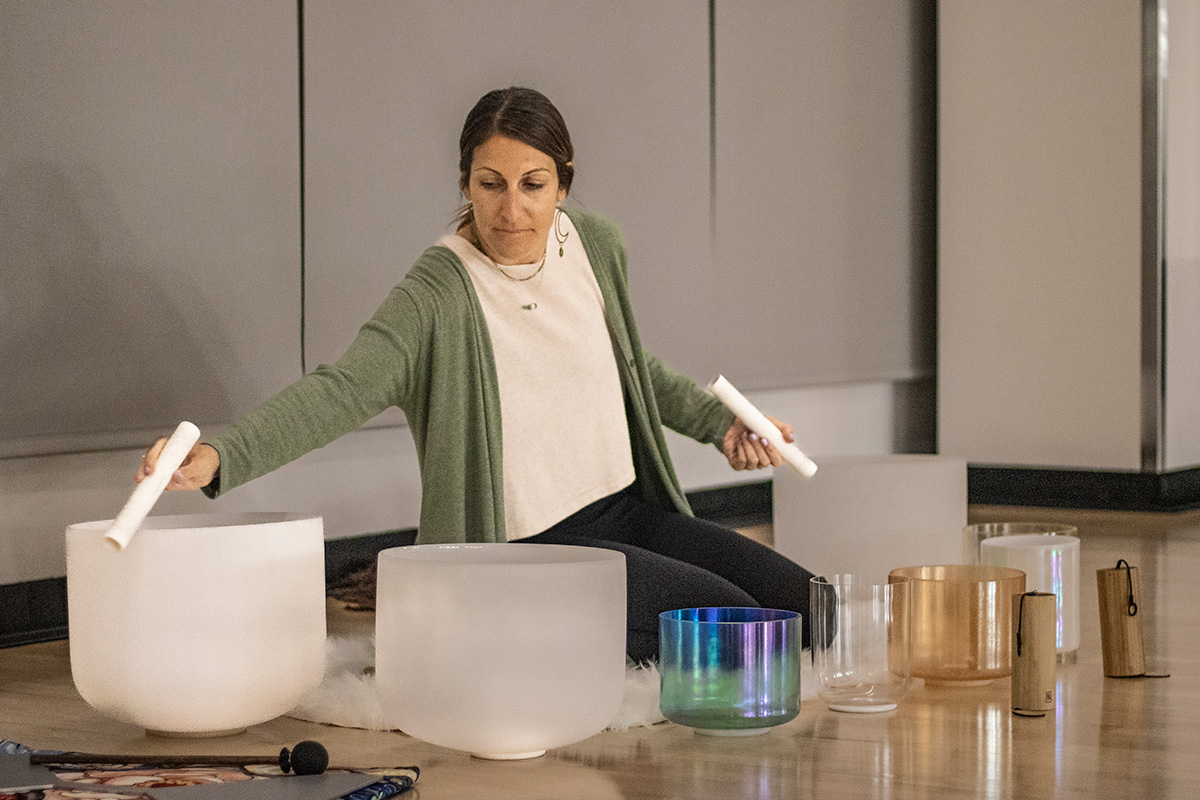Collaboration is Key for Undergraduate Projects
By Sarah White
Engineering meets design
School of Art and Design professor Yin Yu mentored interior architecture student Gina Ferguson and electrical and computer engineering student Brad Dela Llana to design wearable soft robotic devices inspired by biological organisms.
In the process of creating a passionflower-like headpiece that moves according to the wearer’s heartbeat, Ferguson stepped out of her comfort zone and learned new skills in 3D modeling, 3D printing and even soldering. Her ultimate design is intended to help individuals visualize their anxiety and emotions.
Side-by-side with Ferguson, Dela Llana solved pneumatic actuator problems, creating a glove with silicone-based peacock-like feathers that inflate and pulse according to hand movements. Drawing on his interests in music, Dela Llana took his device a step further, adding electronics so that the wearer’s hand movements control song volume and speed. The end result is a device that provides haptic feedback and enhances the visual dynamism of a musician’s performance.
Selling sound bathing
Anthropology undergraduates Emma Fitzpatrick and Amara Golden transcribed interviews under the guidance of professor Elisa (EJ) Sobo to investigate the popularity and perceived effectiveness of sound baths. Sound bathing is a form of therapy that uses resonant bowls, chimes and other instruments to elicit a relaxed, meditative state.
Fitzpatrick extended this research through an independent study project, conducting a survey of students’ awareness and opinions of alternative wellness practices. She also systematically analyzed sound bath advertisements for their most prevalent characteristics.
“Master’s students don’t always get to design their own project, so
this felt like a really unique opportunity,” Fitzpatrick said. Completing the project
without the end goal of a final grade helped her gain more self-confidence in academic
settings.
Applying their findings, Fitzpatrick and Golden organized and advertised a free on-campus sound bath to address the financial and physical accessibility barriers students face when considering participating in such an experience.

Deception detection
Computer science major Christopher Fisher and linguistics major Emily McHale worked with computational psycholinguist Gabriel Doyle to detect lies told by ChatGPT.
Fisher annotated ChatGPT-generated text about common and obscure topics (e.g., facts about Robert F. Kennedy versus a niche Soundcloud rapper) for how accurate each statement was, finding that over one-third of responses generated by ChatGPT contained partially or completely false information.
McHale assessed perceptions of how human-like, trustworthy and convincing ChatGPT-generated film reviews were compared to reviews written by humans, identifying features that readers thought differentiated them.
“This was one of the first times I have felt that my contributions to a subject could matter in the sense that they could serve for others to expand and test more than I could,” McHale said. She hopes her experience conducting her own experiment has prepared her to succeed in a linguistics graduate program.
Dancing through life
“Engaging in dance research is a unique adventure with surprising outcomes,” said Chasley (Chazz) Schoettle, dance and kinesiology major. She and fellow dancer Alyssa Moreno asked the question, “What if my most technical dancing is fiction and my drama is truth?” through iterative reflection on emergent choreography.
They rehearsed with specified roles as mover and witness, attending to each others’ gestures and learning to be vulnerable in the process of allowing their partner to control their body movements. Their movement explorations were incorporated into a larger, binational dance project by their mentor, Jess Humphrey.
Schoettle infused what she learned about the mind-body connection from her collaborative dances with Moreno into a routine that incorporates both ballet and breaking.
Moreno said this experience helped her heal internal turmoil related to her challenges frequently crossing the Tijuana-San Diego border. She expressed these reflections on her bicultural identity and further dance research into a subsequent performance at the SDSU Student Symposium.
Ensuring water safety
The Tijuana-San Diego border region is facing a public health crisis due to sewage leaking into waterways and into the ocean. Environmental engineering student Charisma Tanaka-Herrera and microbiology major Aaliyah Ringor joined engineering professor Matthew Verbyla’s Safe WaTER lab to devise new methods to trace the sources of human fecal pollution.
With additional mentorship from doctoral student Maryam Fani, the team measured how quickly bacteria and viruses commonly found in human waste traveled through soil. Replicating environmental conditions that would be found in San Diego locations, they were able to determine how far away pollution likely originated, narrowing down the possible leaks, runoff or sewage treatment plant contamination sources.
Ringor said participating in this project helped her grow as a scientist and gave her the preliminary knowledge and experience she needs to achieve her dream career working in research.


